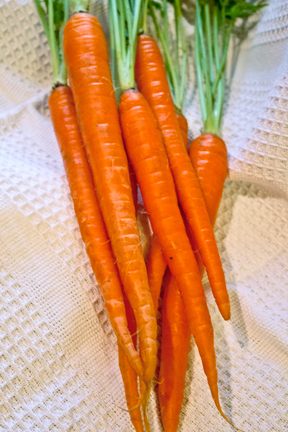Carrots, A Colorful History
 Last week I wrote about how to grow carrots. For a long time, growing root vegetables intimidated me. It was rather silly. All plants have roots, so what was the mystery about these plants with edible roots? Was there some kind of magic involved? A ritual maybe? Ancient secrets past down from ancient astronauts? In reality, none of these implied-in-my-head factors applied. Root vegetables like carrots are rather easy to grow. Like every plant, root vegetables have some individual requirements, but nothing outlandish. They are not divas, and are rather fun and colorful.
Domestic carrots originated around Afghanistan in colors of purple, red and white. Yellow carrots appeared in Turkish writings in the 900s, and the Dutch developed the orange carrot in the 1600s. There are black carrots that are grown in some countries today that include Turkey, Syria and Egypt. They are grouped with the purple varieties. That's quite a history. Queen Anne's Lace, the carrot's wild cousin, grows from the Mediterranean region to Asia and North America. The root of Queen Anne's Lace is woody and not edible, but does have herbal medicinal uses.
Last week I wrote about how to grow carrots. For a long time, growing root vegetables intimidated me. It was rather silly. All plants have roots, so what was the mystery about these plants with edible roots? Was there some kind of magic involved? A ritual maybe? Ancient secrets past down from ancient astronauts? In reality, none of these implied-in-my-head factors applied. Root vegetables like carrots are rather easy to grow. Like every plant, root vegetables have some individual requirements, but nothing outlandish. They are not divas, and are rather fun and colorful.
Domestic carrots originated around Afghanistan in colors of purple, red and white. Yellow carrots appeared in Turkish writings in the 900s, and the Dutch developed the orange carrot in the 1600s. There are black carrots that are grown in some countries today that include Turkey, Syria and Egypt. They are grouped with the purple varieties. That's quite a history. Queen Anne's Lace, the carrot's wild cousin, grows from the Mediterranean region to Asia and North America. The root of Queen Anne's Lace is woody and not edible, but does have herbal medicinal uses.
It was the French seedhouse, Vilmorin-Andriueux in the late 1880s that developed a lot of today's carrot varieties, including the Nantes and Chantenay. Miniature, Imperator and Danvers round out the list to five varieties, and this chart is a good reference.
Jaune De Doubs is a french heirloom variety that dates back to the 19th century. From Fedcoseeds.com;
Jaune du Doubs Carrot (78 days) Open-pollinated. I like this 19th century French heirloom best of all the yellow carrots. Holli Cederholm, another admirer, calls it “a mainstay in her open-pollinated rainbow carrot bunches,” and reports it performed beautifully on her heavy and rocky new ground—with fewer culls than #2076 Danvers or Dragon. Not everyone agrees. Some are put off by its sometimes rough unrefined appearance and variable taste and texture. We advise working your seed bed well before sowing to avoid forked or shallow roots. The plants have the kind of dense rampant wildness that has been tamed out of the newer hybrids, so thin them more rigorously than other varieties. Well-grown they produce smooth conical 5–8" yellow roots, showing slight green shoulders and good core color. Better flavor cooked than raw and retains good color. Cederholm reports that the roots stay crisp and crunchy in storage for tri-colored carrot slaw all winter.
Fast forward to a modern variety, Purple Dragon, which has the same amount of lycopene as tomatoes.When plants breeders create varieties that boost nutritional value that's a win. First and foremost food is nutrition, not a pesticide. That is the difference between hybrids and GMOs.
Off the soapbox and back to history, there is the White Belgian, a carrot grown historically for feed, but yet is a great tasting carrot. It's important to note that carrots have been grown for animal feed as well as the farmer's table. Perhaps that's one reason it took until the late 1800s for them to be reinvented for popular consumption. I grew White Belgians last year, but due the schedule I had, they fell to wayside. They got in the container too late, and languished in the intense heat we had in July 2012. I did get some long, very narrow carrots, and the taste was superb. It was this taste that inspired me to do it right this year. I'm adding Purple Dragons to my list, recommend by a cousin and a good friend, both who know gardening well, and Jaune De Doubs.
Atomic Red Carrots add red to the carrot color spectrum, The red is from lycopene. They are a imperator type, and are a good cooking carrot.
For miniature carrots, there are Paris Market, a round orange french heirloom, Little Fingers, a short cylindrical orange carrot, and Parmex Baby Ball Carrots, an improved version of the Paris Market that does not need peeling. The Parmex link also has Adelaide Baby Carrots listed.
For juicing, try the Healthmaster variety, an orange Danvers type. Also, any of the purple varieties would be good for juicing since they are full of antioxidants and lycopene.
This is a just sample of what's out there for carrot varieties. There are festivals around the world that honor this colorful and healthy root, and there's an International Carrot Day too. But the ultimate tribute in my book is the association with Bugs Bunny, a beloved cultural icon, my favorite cartoon character and an appropriate association.
